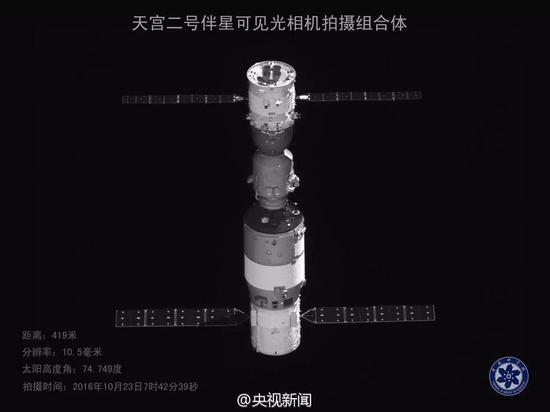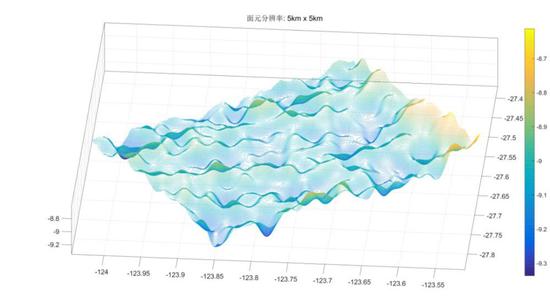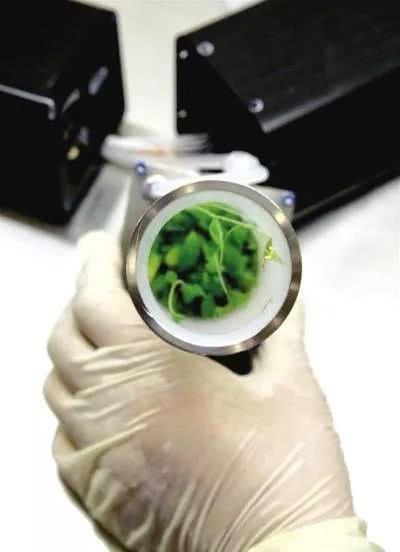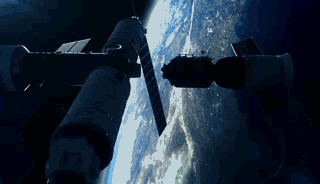Chinese only scheduled mission experiments like these for 天宫2号。 including space vegetable growth. Already sent back vegetable and must had eaten and Pang Sai already! No further mission plan for 天宫2号。Can let it crash on White House like an asteroid!
https://mil.news.sina.com.cn/dgby/2019-07-20/doc-ihytcerm5035764.shtml
成功实施太空“种田”:回顾天宫二号的一生
成功实施太空“种田”:回顾天宫二号的一生
26
2019年7月19日21时06分,在轨运行1036天后,天宫二号受控离轨并再入大气层,少量残骸落入南太平洋预定安全海域,标志着中国载人航天工程空间实验室阶段全部任务圆满完成。
征程
2016年9月15日,天宫二号在九泉卫星发射中心成功发射。
2016年10月19日,神州十一号载人飞船与天宫二号自动交会对接成功。景海鹏和陈冬入驻天宫二号空间实验室,开始了为期33天的太空驻留生活。
2017年4月22日,天舟一号货运飞船与天宫二号顺利完成自动交会对接。4月27日天舟一号与天宫二号完成了首次推进剂在轨补加试验,
中国也因此成为世界上第二个在太空实现在轨推进剂补加的国家。
2017年6月19号,天舟一号以高难度动作顺利完成了与天宫二号的第二次交会对接试验,巩固了航天器多方位空间交会技术。
伴随卫星拍摄的天宫二号神舟飞船组合体图像
使命
天宫二号是中国一个真正意义上的空间实验室,在轨工作的1000多天里,支持开展了4大领域8个主题14项高水平的空间科学与应用任务,也是中国迄今为止领域最广、规模最大、系统最复杂的空间科学与应用任务。
在不到三年的时间里,天宫二号取得了一系列亮眼的科学成果。
空间基础物理学前沿取得重大突破,重点领域方向进入世界先进行列
例如,超高精度空间冷原子钟实验在国际上首次实现了在轨运行。根据在轨测试结果推算,冷原子钟日稳定度达到了7.2×10^-16(误差仅为3000万年一秒),处于国际领先水平。
空间冷原子钟
世界上首台大面积、大视场、高精度伽马暴偏振探测仪,开辟了伽马暴偏振探测新窗口,共计探测到了55个伽马暴。同时,国内首次实现了利用观测到的蟹状星云脉冲星信号进行定轨;成功探测到了若干太阳X射线暴。
地球科学观测和应用新技术领域实现了技术体制创新发展,取得显著的应用效益
多角度宽波段成像光谱仪、三维微波成像高度计、紫外临边成像光谱仪,对陆地、海洋和大气进行观测和遥感应用,达到了国际先进水平,而且相关技术体制已经应用到海洋动力卫星等国家重点任务中。
东太平洋海域的三维海面
多个空间科学领域发现新现象 获得特色鲜明的科学成果
在长周期空间高等植物培养实验中,拟南芥和水稻幸运地当选“植物宇航员”,6个月便完成了我国首次“从种子到种子”高等植物全周期培养实验,为人类长期探索空间提供重要保障。
天宫二号高等植物培养实验返回单元-拟兰芥开花
微重力流体物理、材料科学实验在宝贵的微重力环境下,也发现了一批新的科学现象,对基础研究和工程应用都有重要价值。
突破并在轨验证多项核心关键技术
除了空间科学实验,天宫二号还突破并在轨验证了数十项战略性空间应用新技术和核心关键技术,自研多个核心探测器件和部组件,验证了多项新型技术体制,实现十余项技术转移转化,显著提高了我国空间科学与应用自主可控能力和原始创新能力。
除此之外,超期服役的天宫二号还拓展进行了多项试验,获得了一批宝贵的科学数据。
总得来说,通过实施天宫二号空间科学与应用任务,为我国空间站中大规模开展空间科学与应用,奠定了坚实基础。
归来
天宫二号原设计寿命为两年左右,现在已经是超期服役的第三年,在此期间,她状态良好,超出预期地完成工作,又在今天谢幕,把留恋留在心底,把舞台交给了未来空间站,也将中国空间科学研究与应用的接力棒成功交接到下一站。
中国空间站
成文前,我们曾有幸拜访中科院空间应用工程与技术中心。这里是载人航天工程空间应用系统的总体单位,天宫二号的14项科学实验全部由这里统筹、支撑。与外界沸腾的声音和我们略感焦灼的心情不同,中心的气氛显得忙碌却平静,科学家们手头的工作一刻未停。天宫二号的谢幕,对于他们来说,意味着上一段征程的结束,但不意味着休息,他们已经投入到未来空间站的总体技术支持工作,踏上新的征途。
在此,让我们致敬天宫二号,致敬所有的科学家和航天人。中国航天,未来可期!
出品:科普中国
制作:中国科学院空间应用工程与技术中心
监制:中国科学院计算机网络信息中心
文字部分由中国科普博览团队
联合中国科学院空间应用工程与技术中心制作
(本文中标明来源的图片已获得授权)
本文来源于”中国科普博览“公众号(kepubolan)
Successfully Implementing Space "Farming": Reviewing the Life of Tiangong 2
Successfully Implementing Space "Farming": Reviewing the Life of Tiangong 2
26
At 21:06 on July 19, 2019, after 1036 days of orbital operation, Tiangong No. 2 was controlled to derail and re-enter the atmosphere, and a small amount of debris fell into the safe sea area of the South Pacific, marking the stage of China's manned space engineering space laboratory. All tasks were successfully completed.
Journey
On September 15, 2016, Tiangong 2 was successfully launched at the Jiuquan Satellite Launch Center.
On October 19, 2016, the Shenzhou 11 manned spacecraft and Tiangong 2 automatically rendezvous and docked successfully. Jing Haipeng and Chen Dong entered the Space Laboratory at Tiangong 2 and began a 33-day space-resident life.
On April 22, 2017, the Tianzhou-1 cargo spacecraft and Tiangong 2 successfully completed the automatic rendezvous and docking. On April 27th, Tianzhou No. 1 and Tiangong No. 2 completed the first propellant on-orbit test, and China became the second country in the world to achieve on-orbit propellant addition in space.
On June 19, 2017, Tianzhou No. 1 successfully completed the second rendezvous and docking test with Tiangong No. 2 with high difficulty, which consolidated the multi-faceted space rendezvous technology of spacecraft.
The image of the Tiangong-2 Shenzhou spacecraft combined with the satellite image of the Tiangong-2 Shenzhou spacecraft combined with satellite shooting
Mission
Tiangong No.2 is a real space laboratory in China. In the more than 1,000 days of on-orbit work, it has supported 14 high-level space science and application tasks in 8 major themes in 4 major fields. The largest and most complex space science and application tasks.
In less than three years, Tiangong 2 has achieved a series of brilliant scientific results.
A major breakthrough has been made in the frontier of space-based physics, and the key areas have entered the world's advanced ranks.
For example, the ultra-high-precision space cold atomic clock experiment has achieved on-orbit operation for the first time in the world. According to the in-orbit test results, the daily stability of the cold atomic clock reaches 7.2×10^-16 (the error is only 30 million years and one second), which is at the international leading level.
Space cold atomic clock space cold atomic clock
The world's first large-area, large-field, high-precision gamma-ray polarization detector opened up a new window for gamma-ray polarization detection, and a total of 55 gamma-ray bursts were detected. At the same time, for the first time in China, the observation of the Crab Nebula pulsar signal was used for orbit determination; several solar X-ray bursts were successfully detected.
Earth science observation and application of new technology areas have achieved technological system innovation and development, and achieved significant application benefits
Multi-angle wide-band imaging spectrometer, three-dimensional microwave imaging altimeter, and ultraviolet edge imaging spectrometer for observation and remote sensing of land, sea and atmosphere have reached the international advanced level, and relevant technical systems have been applied to national key tasks such as ocean power satellites. in.
Three-dimensional sea surface in the East Pacific Ocean in the three-dimensional sea surface of the East Pacific Ocean
Discover new phenomena in multiple space science fields and obtain distinctive scientific results
In the long-period space higher plant culture experiment, Arabidopsis and rice were fortunately elected as “plant astronauts”, and completed the first full-cycle culture experiment of “from seed to seed” in China in 6 months, which is a long-term space for human exploration. Provide important protection.
Tiangong No. 2 Higher Plant Culture Experiment Return Unit - Phalaenopsis flowering Tiangong No. 2 higher plant culture experiment return unit - orchid flowering
Microgravity fluid physics and materials science experiments have discovered a number of new scientific phenomena in the precious microgravity environment, which are of great value to basic research and engineering applications.
Break through and verify many key technologies in the track
In addition to space science experiments, Tiangong 2 also broke through and verified dozens of strategic space application new technologies and core key technologies, and self-developed multiple core detectors and components to verify a number of new technology systems and achieve ten The transfer and transformation of the remaining technologies has significantly improved the independent controllability and original innovation capability of space science and application in China.
In addition, Tiangong 2, which has been in service for a long time, has also carried out a number of experiments and obtained a number of valuable scientific data.
In general, the implementation of the Tiangong-2 space science and application mission has laid a solid foundation for the large-scale development of space science and applications in China's space stations.
Return
The original design life of Tiangong No. 2 is about two years. Now it is the third year of overtime service. During this period, she is in good condition and finished her work more than expected. She is now closed today, leaving her love in her heart and giving the stage to her heart. The future space station also successfully handed over the baton of Chinese space science research and application to the next stop.
China Space Station China Space Station
Before writing, we had the opportunity to visit the Space Application Engineering and Technology Center of the Chinese Academy of Sciences. Here is the overall unit of the manned space engineering space application system. The 14 scientific experiments of Tiangong 2 are all coordinated and supported here. Unlike the boiling sounds of the outside world and our slightly anxious mood, the atmosphere in the center is busy but calm, and the work of the scientists is not stopped. The curtain call of Tiangong 2 means, for them, the end of the previous journey, but it does not mean rest. They have already invested in the overall technical support work of the future space station and embarked on a new journey.
Here, let us pay tribute to the Tiangong II, pay tribute to all scientists and astronauts. China Aerospace, the future can be expected!
Produced by: Science China
Production: Center for Space Application Engineering and Technology, Chinese Academy of Sciences
Producer: Computer Network Information Center, Chinese Academy of Sciences
Text section by China Science Expo Team
Co-production by the Space Application Engineering and Technology Center of the Chinese Academy of Sciences
(The image of the source indicated in this article has been authorized)
This article is from the "China Science Expo" public number (kepubolan)










